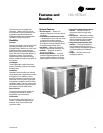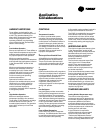
9CG-PRC007-EN
Application
Considerations
Certain application constraints should be
considered when sizing, selecting and
installing Trane air-cooled chillers. Unit
and system reliability is often dependent
upon proper and complete compliance
with these considerations. Where the
application varies from the guidelines
presented, it should be reviewed with
your local Trane sales engineer.
Note: The terms water and solution are
used interchangeably in the following
paragraphs.
UNIT SIZING
Unit capacities are listed in the
“Performance Data” section.
Intentionally oversizing a unit to assure
adequate capacity is not recommended.
Erratic system operation and excessive
compressor cycling are often a direct
result of an oversized chiller. In addition,
an oversized unit is usually more
expensive to purchase, install, and
operate. If oversizing is desired, consider
using two units.
UNIT PLACEMENT
1
Setting The Unit
A base or foundation is not required if
the selected unit location is level and
strong enough to support the unit’s
operating weight (see “Weights” section
of this catalog).
For a detailed discussion of base and
foundation construction, refer to the
Trane Reciprocating Refrigeration
Manual. Manuals are available through
the local Trane office.
2
Isolation and Sound Emission
The most effective form of isolation is to
locate the unit away from any sound
sensitive area. Structurally transmitted
sound can be reduced by using spring
isolators. Spring isolators are generally
effective in reducing vibratory noise
generated by compressors, and
therefore, are recommended for sound
sensitive installations. An acoustical
engineer should always be consulted on
critical applications.
Debris, trash, supplies, etc., should not
be allowed to accumulate in the vicinity
of the air-cooled chiller. Supply air
movement may draw debris into the
condenser coil, blocking spaces between
coil fins and causing coil starvation.
Both warm air recirculation and coil
starvation cause reductions in unit
efficiency and capacity because of the
higher head pressures associated with
them. In addition, in more severe cases,
nuisance unit shutdowns will result from
excessive head pressures. Estimates of
the degree of efficiency and capacity
reduction in such situations can be
determined. Consult your local Trane
sales engineer.
Cross winds, those perpendicular to the
condenser, tend to aid efficient operation
in warmer ambient conditions, however,
they tend to be detrimental to operation
in lower ambients or when hot gas
bypass is used due to the accompanying
loss of adequate head pressure. As a
result, it is advisable to protect air-cooled
chillers from continuous direct winds
exceeding 10 miles per hour in low
ambient conditions.
Low Ambient Operation — 20-60 Ton
models — Human Interface
Recommendations
When the temperature outside is
subzero, who wants to be out there
monitoring or troubleshooting
diagnostics? Because we understand a
service technician’s reluctance to do this,
we recommend using a Remote Human
Interface (RHI) panel. The service
technician can troubleshoot and
diagnose in the comfort of a mechanical
room.
For maximum isolation effect, water lines
and electrical conduit should also be
isolated. Wall sleeves and rubber isolated
piping hangers can be used to reduce the
sound transmitted through water piping.
To reduce the sound transmitted through
electrical conduit, use flexible electrical
conduit.
State and local codes on sound
emissions should always be considered.
Since the environment in which a sound
source is located affects sound pressure,
unit placement must be carefully
evaluated. Sound pressure and sound
power levels for chillers are available on
request.
3
Servicing
Adequate clearance for evaporator and
compressor servicing should be
provided. Recommended minimum
space envelopes for servicing are located
in the dimensional data section and can
serve as a guideline for providing
adequate clearance. The minimum space
envelopes also allow for control panel
door swing and routing maintenance
requirements. Local code requirements
may take precedence.
4
Unit Location
a
General
Unobstructed flow of condenser air is
essential to maintain chiller capacity and
operating efficiency. When determining
unit placement, careful consideration
must be given to assure a sufficient flow
of air across the condenser heat transfer
surface. Two detrimental conditions are
possible and must be avoided: warm air
recirculation and coil starvation.
Warm air recirculation occurs when
discharge air from the condenser fans is
recycled back to the condenser coil inlet.
Coil starvation occurs when free airflow
to the condenser is restricted.
Condenser coils and fan discharge must
be kept free of snow or other
obstructions to permit adequate airflow
for satisfactory unit operation.


















